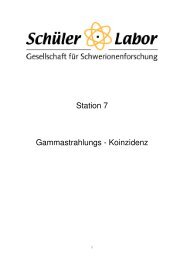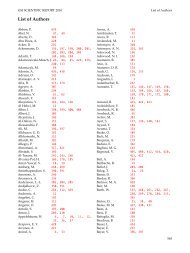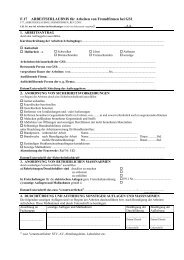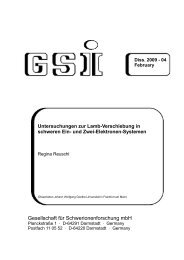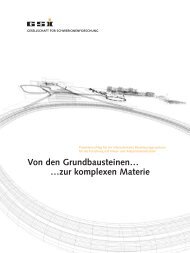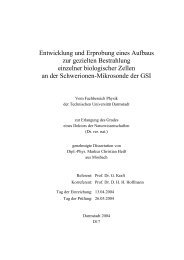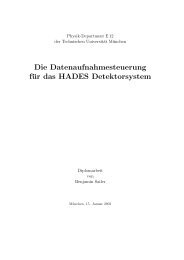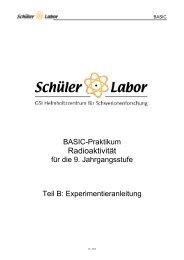CBM Progress Report 2006 - GSI
CBM Progress Report 2006 - GSI
CBM Progress Report 2006 - GSI
Create successful ePaper yourself
Turn your PDF publications into a flip-book with our unique Google optimized e-Paper software.
Detector Developments <strong>CBM</strong> <strong>Progress</strong> <strong>Report</strong> <strong>2006</strong><br />
Ceramic high-rate timing RPCs<br />
L. Lopes 1 , R. Ferreira Marques 1,2 , P. Fonte 1,3 , L. Hennetier 4 , A. Pereira 1 and A.M. Sousa Correia 4<br />
1 Laboratório de Instrumentação e Física Experimental de Partículas, Coimbra, Portugal, 2 Departamento de Física,<br />
Faculdade de Ciências e Tecnologia da Universidade de Coimbra, Coimbra, Portugal, 3 Instituto Superior de Engenharia<br />
de Coimbra, Coimbra, Portugal, 4 Centro Tecnológico da Ceramica e do Vidro, Coimbra, Portugal<br />
Timing resistive plate chambers [1] are planar gaseous<br />
detectors made with a combination of metallic and resistive<br />
electrodes, which deliver a time resolution around 50 ps<br />
sigma (σ) and efficiency up to 99% for MIPs. This is currently<br />
the only practical technology envisaged for the <strong>CBM</strong><br />
TOF Wall.<br />
The counting rate capability of these detectors is mainly<br />
determined by the resistivity of the electrodes, which are<br />
typically made of glass with volume resistivity between<br />
10 12 and 10 13 Ω·cm. This limits the maximum counting<br />
rate to around 2 kHz/cm 2 [2], which is insuficient for the<br />
central regions of <strong>CBM</strong>.<br />
Here we report on the use of a ceramic commercial material<br />
with a measured resistivity of 10 9 Ω·cm and free<br />
from charge depletion effects [3]. The results establish the<br />
practical feasibility of accurate timing measurements with<br />
RPCs at rates up to 75 kHz/cm 2 - largelly suficient for aplication<br />
in <strong>CBM</strong> - while keeping a time resolution below<br />
100 ps σ for 511 keV gamma rays. Full details may be<br />
found in [4].<br />
Figure 1: a) Counting rate density as a function of the X-ray tube<br />
current for a set of applied voltages. A fitting quadratic polynomial reproduces<br />
well the data (one example shown). b) The data points are normalized<br />
to the linear part of the fitting polynomial (the “incident” counting<br />
rate, also represented in a)), yielding the drop in relative efficiency that<br />
may be attributed to the counting rate. A general linear fit to these points<br />
shows a slope of 9% relative efficiency drop per 100 kHz/cm 2 .<br />
40<br />
Figure 2: Time resolution as a function of the counting rate. Within the<br />
statistical fluctuations of the measurement, the time resolution remains<br />
essentially unchanged, around 90 ps σ, between 1 and 75 kHz/cm 2 . The<br />
applied voltage was adjusted as the counting rate increased in order to<br />
compensate for voltage change across the ceramic.<br />
The counting rate density as a function of the X-ray tube<br />
current for a set of applied voltages is shown in Fig. 1 a).<br />
For each voltage the data is well described by a quadratic<br />
polynomial. The relative sensitivity drop that may be attributed<br />
to the increasing counting rate (Fig. 1 b)) is estimated<br />
by normalizing the data points to the linear part<br />
of the fitting polynomial (the “incident” counting rate, also<br />
represented in a)). A linear fit to the set of the normalized<br />
points shows a slope of 9% relative sensitivity drop<br />
per 100 kHz/cm 2 .<br />
Time resolution results are shown in Fig. 2. Within the<br />
statistical fluctuations of the measurement (vertical spread<br />
of the points), the time resolution remains essentially unchanged<br />
around 90 ps σ, between 1 and 75 kHz/cm 2 . Beyond<br />
this point the measurement becomes impossible owing<br />
to the predominance of random coincidences (see [5]).<br />
It should be noted that the performance of timing RPCs<br />
in particle beams and with 511 keV photons has been compared<br />
and it was found that with photons the resolution is<br />
systematically worse.<br />
This work was supported by the EU FP6 program via the<br />
contract RII3-CT-2003-506078 and by FCT and FEDER<br />
under project POCI/FP/63411/2005.<br />
References<br />
[1] Nucl. Instr. and Meth., A443 (2000) 201.<br />
[2] Nucl. Instr. and Meth., A490 (2002) 58-70.<br />
[3] AL-940CD charge-dissipative ceramics, Morgan Ceramics.<br />
[4] Nucl. Phys. B - Proc. Sup., 158 (<strong>2006</strong>) 66-70, <strong>CBM</strong>-TOFnote-<strong>2006</strong>-001.<br />
[5] Nucl. Instr. and Meth., in press<br />
(http://dx.doi.org/10.1016/j.nima.<strong>2006</strong>.10.245).



